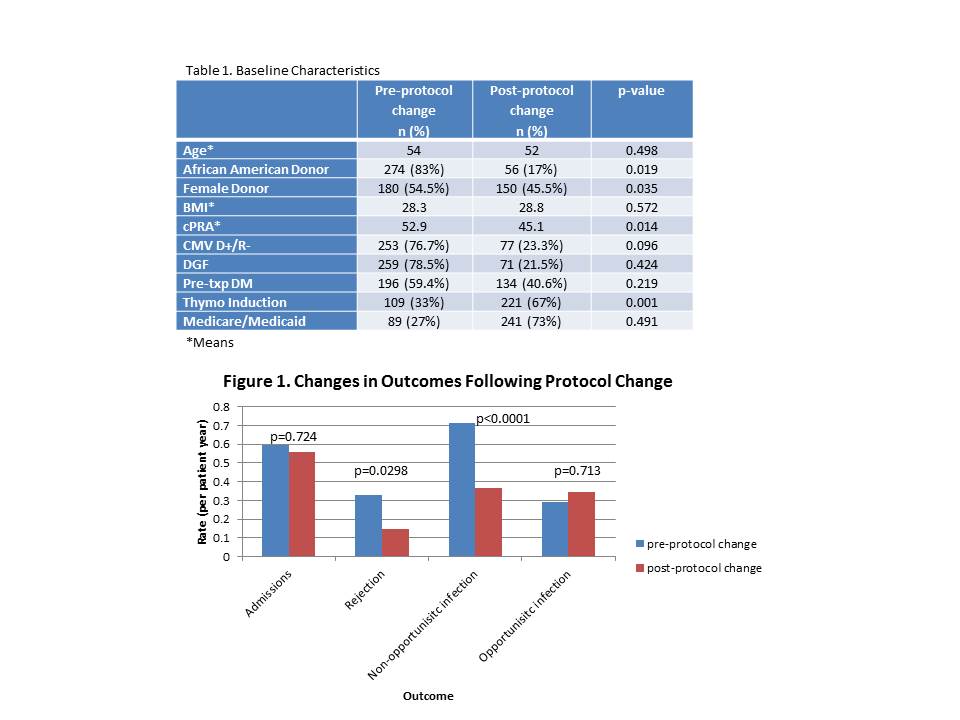Clinical Outcomes in Kidney Transplant Recipients Following Implementation of a Strategic Maintenance Reduction Protocol
Pharmacy, Medical University of South Carolina, Charleston, SC
Meeting: 2020 American Transplant Congress
Abstract number: C-121
Keywords: Immunosuppression, Infection, Kidney transplantation
Session Information
Session Name: Poster Session C: Kidney Immunosuppression: Novel Regimens and Drug Minimization
Session Type: Poster Session
Date: Saturday, May 30, 2020
Session Time: 3:15pm-4:00pm
 Presentation Time: 3:30pm-4:00pm
Presentation Time: 3:30pm-4:00pm
Location: Virtual
*Purpose: Post-transplant complications are commonly due to over-immunosuppression, particularly as it relates to infections. The purpose of this study was to assess clinical outcomes in kidney transplant (KTX) recipients before and after the implementation of an immunosuppression reduction protocol.
*Methods: This was a single center retrospective longitudinal cohort study of KTX recipients from January 2017 to February 2019. Patients were excluded if they were < 18 yo, transferred care to an outside facility, received a multiorgan transplant or were taking investigational immunosuppression. The immunosuppression protocol change reduced mycophenolate from 1000 mg BID to 750 mg PO BID at 1-month and prednisone reduced from 20 mg at discharge to 10 mg at discharge tapering to 5 mg daily at 1-month. Outcome assessments included opportunistic and non-opportunistic infections, incidence and management of diabetes, overall treated rejection, hospitalizations, ED visits and overall patient and graft survival.
*Results: A total of 567 KTX recipients were analyzed with 496 included in the study. Most baseline characteristics were similar between the pre and post-protocol cohorts; however, in the post-protocol cohort, there was more thymoglobulin induction, more female donors, fewer African-American donors and more CMV D+/R- recipients (Table 1). In an adjusted cox regression model, there was a 63% lower risk of graft loss following the protocol change (HR 0.436, 95% CI 0.193 to 0.983, p=0.001). In adjusted modelling, the post-protocol change cohort also demonstrated a 52% lower incidence of rejection (IRR 0.48, put in 95% CI -1.37 to -0.07 p=0.0298) and 50% lower risk of non-opportunistic infections (IRR 0.50, 95% CI -0.94 to -0.42, p<0.0001, Figure 1). Finally, the post-protocol patients also had a 23% fewer hospital readmission days, which did not reach statistical significance (IRR 0.77, 95% CI -0.67 to 0.16, p=0.228).
*Conclusions: The implementation of an immunosuppression reduction protocol in kidney transplant recipients was associated with a significant reduction in the risk of non-opportunistic infections, acute rejection and graft loss. Center specific protocols should continually be assessed for modifications in order to produce optimal outcomes while minimizing complications.
To cite this abstract in AMA style:
Perkins H, Foster K, Patel N, Meadows H, Bartlett F, Perez C, McGillicuddy J, Pilch N, Casey M, Posadas-Salas MA, Taber D. Clinical Outcomes in Kidney Transplant Recipients Following Implementation of a Strategic Maintenance Reduction Protocol [abstract]. Am J Transplant. 2020; 20 (suppl 3). https://atcmeetingabstracts.com/abstract/clinical-outcomes-in-kidney-transplant-recipients-following-implementation-of-a-strategic-maintenance-reduction-protocol/. Accessed January 2, 2026.« Back to 2020 American Transplant Congress

